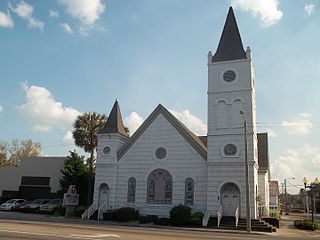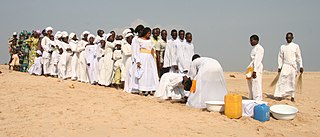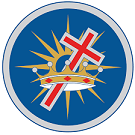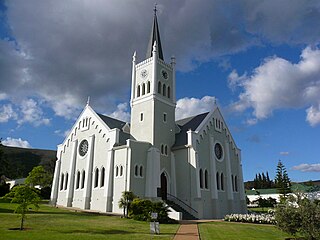Polokwane, also known as Pietersburg, is a city and the capital of the Limpopo Province of South Africa. It is South Africa's largest urban centre north of Gauteng. It was one of the host cities of the 2010 FIFA World Cup.

The African Methodist Episcopal Zion Church, or the AME Zion Church (AMEZ) is a historically African-American Christian denomination based in the United States. It was officially formed in 1821 in New York City, but operated for a number of years before then. The African Methodist Episcopal Zion Church adheres to Wesleyan-Arminian theology.

The black church is the faith and body of Christian denominations and congregations in the United States that predominantly minister to, and are also led by African Americans, as well as these churches' collective traditions and members. The term "black church" may also refer to individual congregations, including in traditionally white-led denominations.
Zionist churches are a group of Christian denominations that derive from the Christian Catholic Apostolic Church, which was founded by John Alexander Dowie in Zion, Illinois, at the end of the 19th century. Missionaries from the church came to South Africa in 1904 and among their first recruits were Pieter Louis le Roux and Daniel Nkonyane of Wakkerstroom who continued to evangelize after the Zionist missionaries left in 1908.

An African-initiated church (AIC) is a Christian church independently started in Africa by Africans rather than chiefly by missionaries from another continent.

The Apostolic Faith Mission of South Africa (AFM) is a classical Pentecostal Christian denomination in South Africa. With 1.2 million adherents, it is South Africa's largest Pentecostal church and the fifth largest religious grouping in South Africa representing 7.6 percent of the population. Dr. Isak Burger has led the AFM as president since 1996 when the white and black branches of the church were united. It is a member of the Apostolic Faith Mission International, a fellowship of 23 AFM national churches. It is also a member of the South African Council of Churches.

Religion of black Americans refers to the religious and spiritual practices of African Americans. Historians generally agree that the religious life of black Americans "forms the foundation of their community life". Before 1775 there was scattered evidence of organized religion among black people in the Thirteen Colonies. The Methodist and Baptist churches became much more active in the 1780s. Their growth was quite rapid for the next 150 years, until their membership included the majority of black Americans.
Pieter Louis Le Roux or PL Le Roux (1865–1943) was a South African missionary, who was a leading figure in the Zion Church movement in South Africa and the Apostolic Faith Mission of South Africa. Le Roux was initially a missionary for the Dutch Reformed Church. He was heavily influenced by the healing ministry of John Alexander Dowie and his Zionist movement which he later joined. Later he joined the Pentecostal movement of John G. Lake and Thomas Hezmalhalch. He was president of the Apostolic Faith Mission of South Africa from 1913 to 1942. His involvement with black leaders in South Africa led to the establishment of a conglomerate of churches from both Zionist and Pentecostal backgrounds, most notably the Zion Christian Church (ZCC).
Ga-Molepo is a town in Capricorn District Municipality and Polokwane Local Municipality in the Limpopo province of South Africa.
Silwerkrans is a village in Bojanala District Municipality in the North West province of South Africa. The village is occupied by the Batlokwa ba Bogatsu tribe. The Batlokwa are thought to have occupied this village during the1800s. The royal house has no Kgosi. Dr. Lesedi Motsatsi is the heir to the throne but has not been enthroned.Tlokweng village has sub-clans (makgotla) led by dikgosana.

Engenas Barnabas Lekganyane was the founder of the Zion Christian Church (ZCC). He first formed the ZCC in 1924, and by the time of his death the church had at least 50,000 members. Under the leadership of his descendants the ZCC has gone on to have more than a million members primarily located in southern Africa. It is now by far the biggest of the various Zionist Christian sects that account for roughly half of all Christians in southern Africa.
Bishop Samuel Mutendi (c.1880-1976) was the founder of the Zimbabwean based Zion Christian Church (Z.C.C), which under his leadership grew to a membership of more than 250,000, and is believed to have grown three or four times larger today and one of the largest religious organizations in the country. As the religious leader responsible for the popularization of Zionist Christianity into Zimbabwe, he is arguably the most influential religious personality in the country's history.

The Swedish Pentecostal Movement is a Pentecostal movement in Sweden. Many, but not all, of these, are members of the Pentecostal Alliance of Independent Churches, which was founded in 2001. The Pentecostal movement spread to Sweden by 1907 from the 1904–1905 Welsh Revival and the Azusa Street Revival in Los Angeles in 1906.
Jeffery Tribble is an ordained elder in the African Methodist Episcopal Zion Church and a professor of ministry with research interests in Practical Theology, Congregational Studies and Leadership, Ethnography, Evangelism and Church Planting, Black Church Studies, and Urban Church Ministry. Academics and professionals in these fields consider him a renowned thought leader. Tribble's experience in pastoral ministry allows for his work to bridge the gap between academic research and practical church leadership.
The Zion Apostolic Faith Mission Church is one of the earliest Zionist sects in southern Africa. It was formed out of a secession from the Pentecostal Apostolic Faith Mission in 1919, and attempted to create southern Africa's second "Zion City" in emulation of John Alexander Dowie. Although ZAFM was initially an influential church in Zionist circles, it failed to develop and prosper over the decades. It is best known today for spawning two secessions of its own that grew into large churches—the Zion Christian Church and the Zimbabwean Zion Apostolic Faith Mission.
Edward Lekganyane, popularly known as "Kgoshi Edward", was the leader of the Zion Christian Church (ZCC) from Easter Sunday, April 17, 1949, until his death eighteen years later. During this time he used his charisma and organizational abilities to expand the ZCC from about 50,000 to 600,000 members, while also reshaping numerous facets of the church. During his tenure as bishop, the ZCC emerged as South Africa's largest independent church, while Lekganyane became arguably the wealthiest and most powerful African in apartheid-era South Africa.
The Rev. Matthys Michielse du Toit was a Christian pastor in the Dutch Reformed Church in South Africa (NGK).
In Methodism, a steward is a member of a local church who is elected by the congregation to help in the practical life of the church. The position of stewards is a hallmark of classic Methodism.

The Dutch Reformed Church in Barrydale is a congregation of the Dutch Reformed Church centered on the village of Barrydale in the picturesque surroundings of the Langeberg on the R62, 62.5 km (38.8 mi) south-east of Montagu, 76 km (47 mi) south-west of Ladismith and more or less equidistant through the Tradouw Pass from Swellendam and Heidelberg. In 2014, the congregation had 49 baptized and 211 professing members. In that year the pastor was Rev. W. J. van Zyl.

The Dutch Reformed Church in Colesberg, with the Northern Cape town of Colesberg as its centre, is the 18th oldest congregation of the Dutch Reformed Church in South Africa, but due to the synodal boundaries that differ from the provincial ones, the fifth oldest in the Synod of Eastern Cape. On 10 December 2011, the congregation was already 185 years old. In 2015, the congregation had 90 baptized and 458 professing members.










